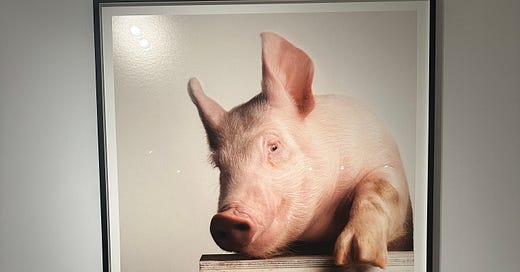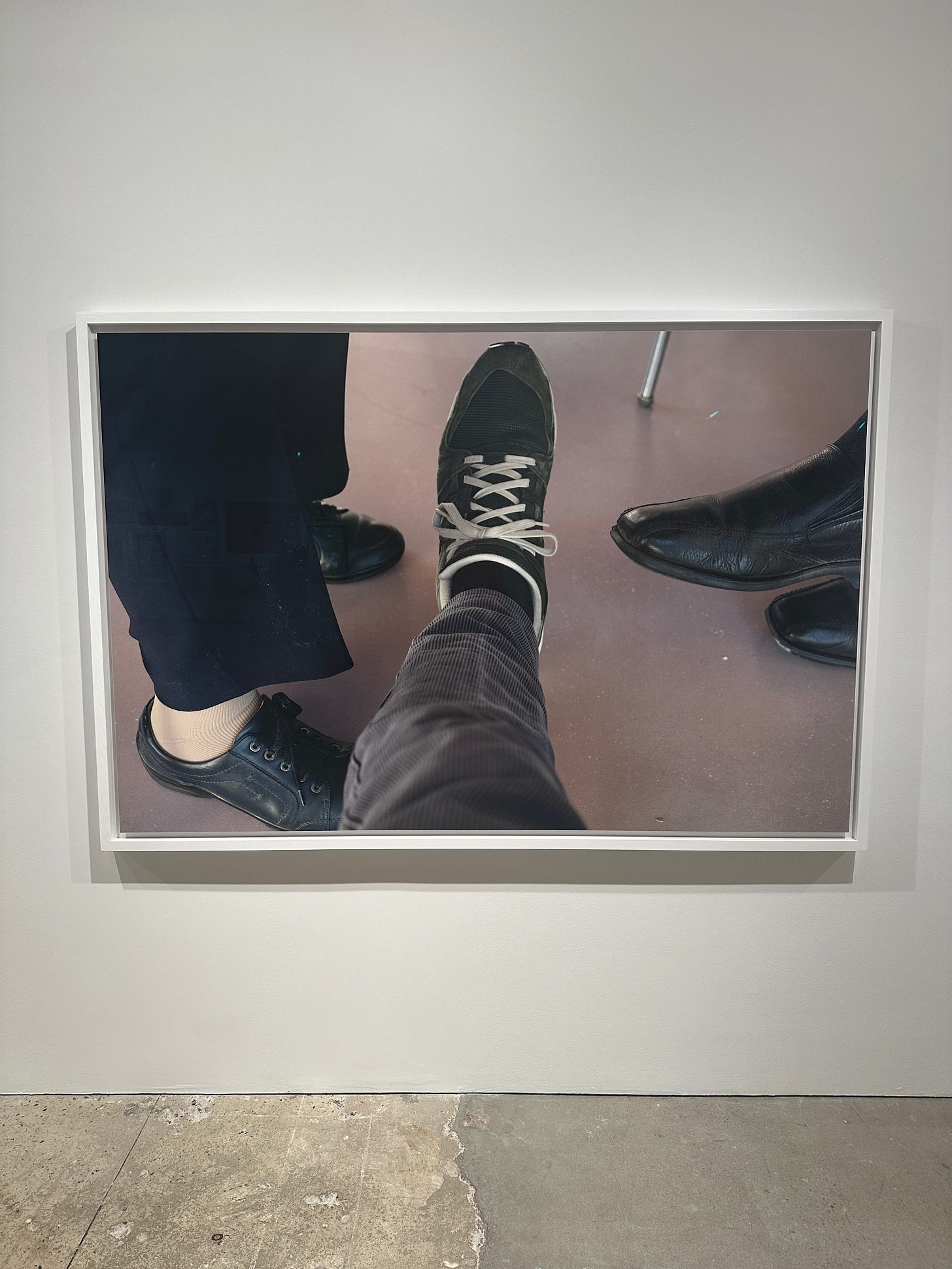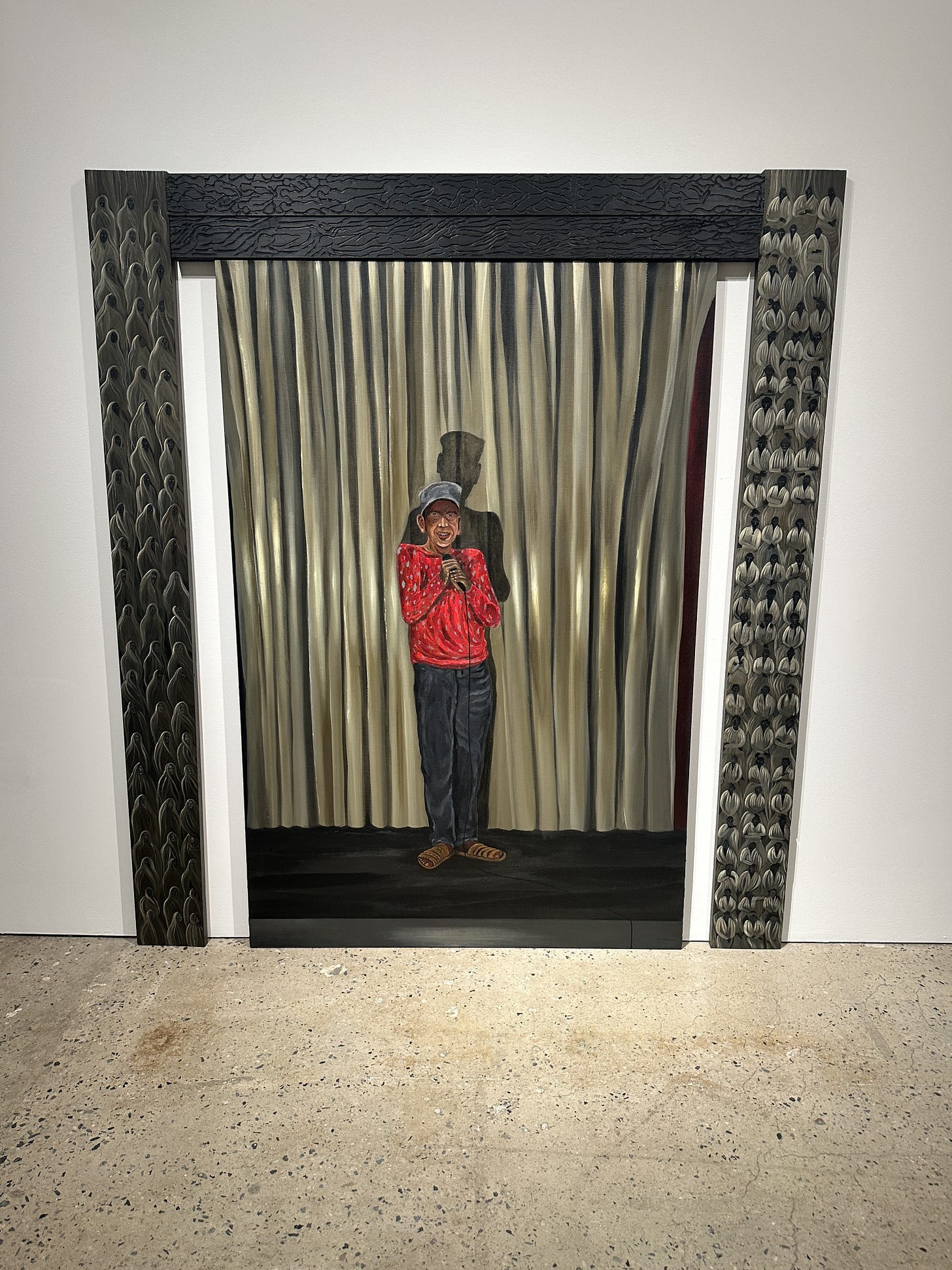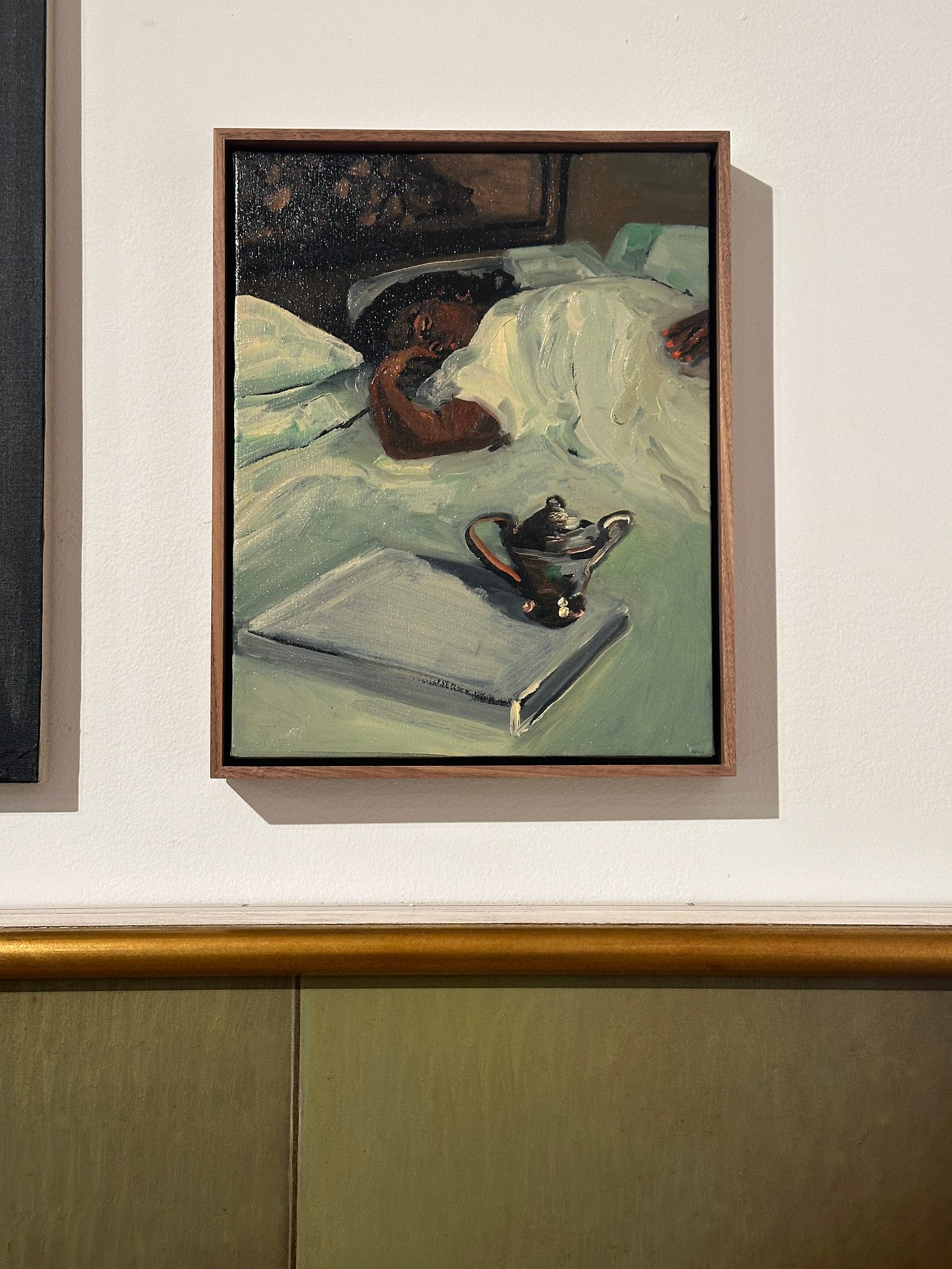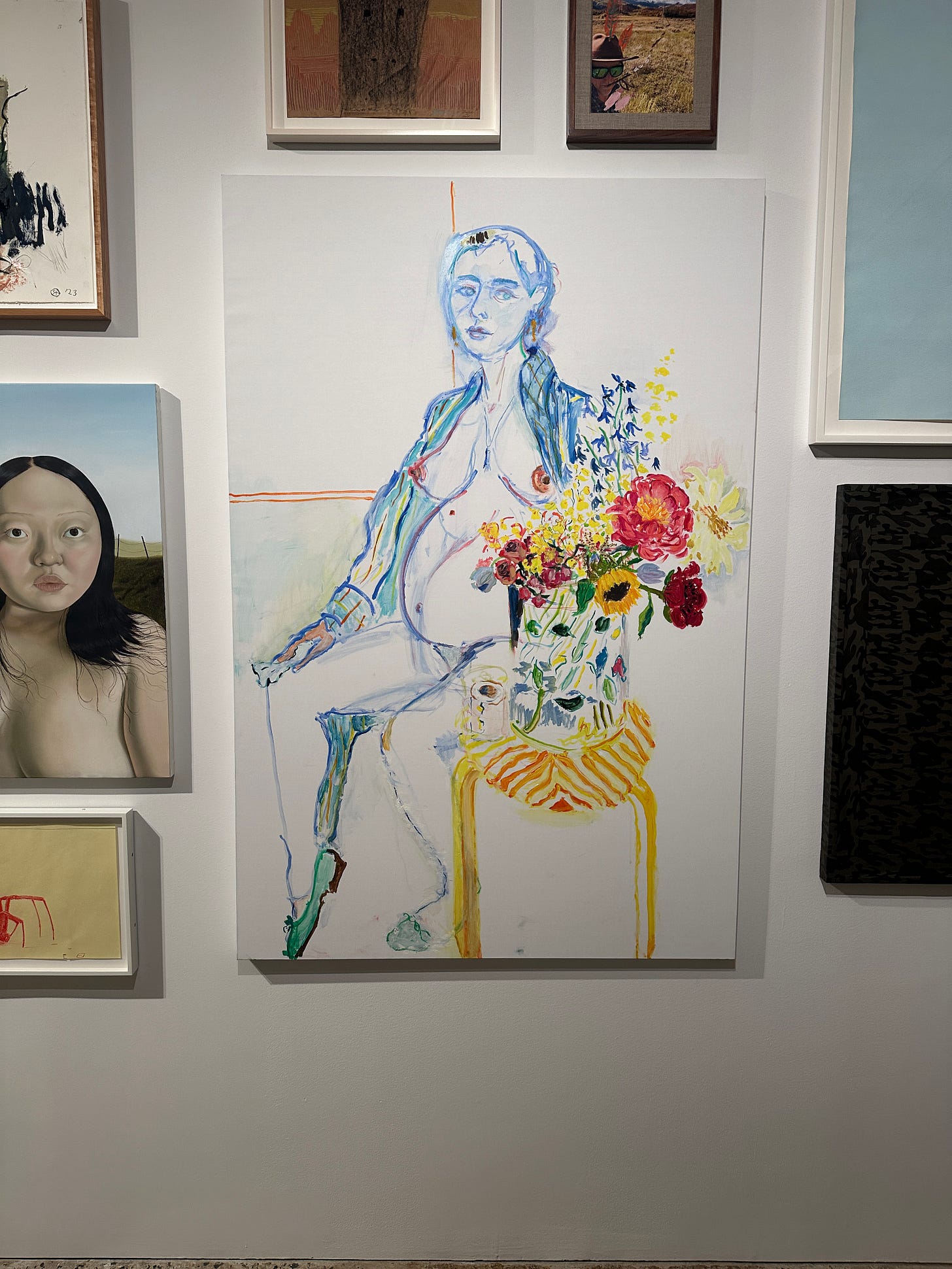Review: Summer Self-Portraits at Nahmad Contemporary
It's worth a visit, but am I wrong to want more from a show like this?
Yours Truly, on view through September 14th, marks the third summer show curated by Eleanor Cayre that I’ve seen at Nahmad Contemporary. The other two shows I saw were also summer group shows and also curated around a theme—the 2023 Ugly Painting and the 2022 Painter’s New Tools. Both previous shows were co-organized with with the writer Dean Kissick. Like the present one, which I believe was organized by Cayre alone, the last two Nahmad summer shows brought together established and emerging artists working on a similar problem. In the last two shows, I appreciated the commitment to a specific theme and the effort to rigorously survey a shifting landscape of trends, especially within the confines of a gallery exhibition, where the organizing principle is often an afterthought. While I appreciate those commitments, I found a lot of the individual works in both past shows to be lackluster. This is always a problem when dealing with the hyper-contemporary, where the closer you get to the present, the more difficult it is to discern what work will outlast its moment.
Overall, I feel similarly about this 2024 summer show. It’s smartly organized and shows a good enough range of contemporary approaches to portraiture—straightforward traditional portraits, abstractions, still lifes, sculptures, works on paper, and photographs. A number of artists who’ve had major gallery or museum retrospectives in the last 3 years are present here, along with several emerging artists I was totally unfamiliar with. As much as I quibble with these shows in the big picture, they consistently introduce me to people I haven’t been paying attention to, which is something I don’t take for granted.
The weakest parts of the show is the inclusion of mediocre works by more commercially successful artists. I’m pretty sure I’ve seen several of these works on view at other galleries saw on view earlier this year and last year. For example, Heji Shin and Arthur Jafa both recently had big shows at 52 Walker. The Jafa photographic self-portrait on aluminum panel is one of his weaker works, kind of a throwaway piece. And for the record I count myself as a Jafa fan! None of Shin’s ultra-high-definition photographs of pigs have done much for me. The idea of recognizing oneself in an image of other species is compelling on the surface, but they seem safe and tepid compared to some of her more daring photography, like her series of newborn babies, or her more dynamic photographs of roosters. I’ll concede that I don’t know as much about photography though, and maybe I’m missing something significant in that.
Fil’s house by Henry Taylor, a painter I love, has some interesting passages, like the Rothko-esque burnt sienna and yellow beer can label at the top left corner, which balances an otherwise cool composition with a hint of warmth. There’s an interesting compositional energy between the verticals and diagonals of the pool noodles, the strands of white-blue that visualize the reflection of the water, and the tilted beer can. It’s not a bad painting, but a little underwhelming for an artist of Taylor’s caliber. It looks a little unfinished. The water beneath the surface is too monotone, making everything a little flatter than it should be. Instead of flatness being in tension with the suggestion of depth, we just get flatness.
Wolfgang Tillmans is another big name, hot off a huge MoMA retrospective in 2022 and another Zwirner show in fall 2023-spring 2024. His 2022 photograph Elternbesuch was pleasing enough to look at, as virtually any Tillmans is. There are three sets of shoes, dust on pants, the metal leg of a desk or a chair in the top left corner. It’s fine. There’s also a typical inkjet on linen painting by Wade Guyton, who just had a show at Matthew Marks in fall 2023. I loved the show at Marks, but again, the painting included here was just so-so. It lacks the overlapping blowouts and disjunctions that define his best work.
You could say the same of the Jaune Quick-to-See Smith mixed media painting or the Jordan Wolfson wall work as well. Why these works specifically? Is there a reason besides the basic fact that they’re available and for sale? Why include so many minor works by blue chip artists? Were better recent works by the same artists not available for loan/consignment? It’s not a museum show; they are trying to sell stuff after all, but a lot of what’s exhibited isn’t bad, it’s just fine. Most of the self-portraits by industry approved artists are market-friendly enough, and generally in line with the taste of the moment, but are we allowed to ask for more? Maybe I’m putting one group show under too much scrutiny. I’m also aware that the constraints of recency. The earliest work in the show is Isa Genzken’s 2015 sculpture. Perhaps this limits the available material, but I don’t think I’m wrong to wonder if there aren’t better and more expansive self-portraits being made right now, even if by the same artists.
Speaking of Genzken, one of the works that resonated the most was her sculpture (wall work?) Flugzeugfenster. The title translates to “airplane window.” It defamiliarizes the already kind of weird dual structure of a pair of airplane windows with reflective silver tape, colored tape, and a pamphlet with a vermeer on it tucked underneath the half open airplane window. A photograph of a finger continues the index of a piece of tape in the top right corner. It looks cheap but oddly balanced and exquisite. The silver tape bisecting the windows seems more carefully crumpled than the other tape. The windows, half open, barely read as a face. It pairs well with the crazy Stuart Middleton relief, and I wish there were more sculpture included generally.
A lot of the paintings I liked in the show were figure paintings. There weren’t nearly as many abstractions, but few of the abstractions that were included worked for me. They were just kinda boring. Of the figure paintings, Abul Hisham’s Ceremonial day speech—portrait of a boy in Red, was a standout. A figure dressed in a red sweater stands in front of a curtain holding a microphone. The frame is two painted columns standing with space between the actual canvas all with rows of figures dressed in cloaks on them. The figures on the right side have hoods off and the left have hoods on. There’s a sliver of maroon peeking from behind the curtain. A wood looking piece at the to connecting the two columns of the frame has little figures engraved in it. It holds honesty and mystery in tension.
Danielle McKinney’s art looked strong in the context of this show as well, though the same painting was on view in Chelsea just a couple months ago. McKinney’s Memoir, recalls the intimate interiors and blue tones of a Cassatt, with flecks of white highlights and red fingernails that draw on the ashcan school. It’s not trying to do too much, I just think it looks nice.
Another one of the stronger figure paintings, the Tobias Spichtig portrait, was also relatively straightforward. It doesn’t reinvent the wheel, but it looks solid, as in the paint is sufficiently built up in layers, and not just thinly spread out across the canvas. The colors are interesting too, like the angular hit of blue around the exaggerated red lips, or the little drips of purple going down the brown-gold background at the top left corner
Also noteworthy was Emily Sundblad’s 2021 La Donna Cannone, which employs a ton of negative space, and very few dark tones. This brings forward the low values, like the darker rose on the right side of the vase, the hit of brown on the heel of her shoe, or the quick swipes of black that act as almost inverted highlights on the top of her head, which is otherwise rendered in a faint blue.
All things considered, it was a pretty solid group show and introduced me to a bunch of artists I wasn’t familiar with. At the same time. I think some mediocrity is to be expected with these summer shows, but I was surprised how many works I’d already seen elsewhere. I’m curious what sells.

